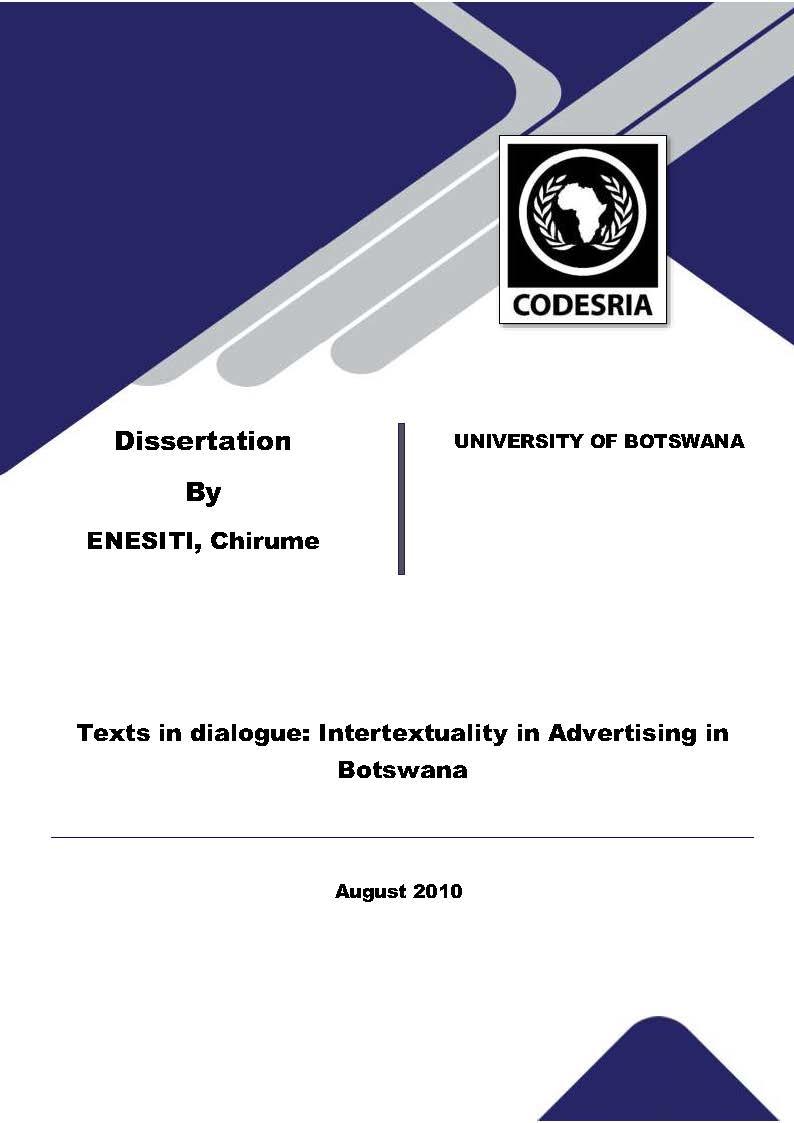Texts in dialogue: Intertextuality in Advertising in Botswana
Mots-clés :
Intertextuality, Botswana, intertextuality in a variety of print advertisements in Botswana, explorationSynopsis
This study sought to investigate and explore the technique of intertextuality in a variety of print advertisements in Botswana. The exploration was undertaken to determine the types of intertextual transfer of meanings and those aspects of culture and texts that inform intertextual meaning transfer in advertising in Botswana. The study attempted to answer questions such as: what forms of intertextuality are found in advertisements in Botswana? What linguistic innovations are achieved in these advertisements? What social domains are the main sources of intertextual reference? How does intertextuality shape social meanings? The study used a Critical Discourse Analysis approach as the main theoretical and analytical framework and relied on qualitative methods of text analysis. As evidenced in a number of advertisements in this study, intertextual messages in
advertising can be regarded as generally-accepted shared knowledge between the marketer and the target market which is based on certain dominant world views. This study found that effective advertising is really intertextual; a process that involves how a given text alludes to and incorporates various other texts. Most importantly, the study established that intertextuality is not only a case where one text alludes to another; a text spreads across associations, different fields, references, metaphors and, as such, intertextuality is a very complex phenomenon whereby a text feeds off and articulates a total history and culture in which it is produced. The study established that in both commercial and social advertisements, intertextual reference occurs. In both types of advertisements, sources of intertextual reference are multiple, complex and often opaque. The study showed that, for the industries that market controversial products, such as cigarettes, advertising is done in such a way that it subverts legislations. The research found out that intertextuality is employed as a device for dominance in the advertising industry. This position of dominance is manifest at various levels, not only with commercial but also with social services advertising. The study
concludes by suggesting that intertextuality is a tool used to market goods and services in an increasingly competitive world, and as such, advertisers need to find new innovative ways of marketing their products. To do this they need to be able to use language in new surprising ways. This involves mixing of discourses to create new hybrid discourses that engage the
reader both intellectually and aestheticaUy. The study also concludes that by doing this, advertisin~ in Botswana contributes significantly to the growth of a consumerist and materialist society.
Téléchargements
Références
Bakhtin, M. (1986). The Dialogic Imagination. Austin TX: University of Texas Press.
Barthes, R. (1977). Image-Music-Text. London: William Collins and Sons.
Berman, G. (1982). Watching Dallas, Soap Opera and the Melodramatic Imagination. London:
Routledge.
Best, J. & Kahn, J.(2006). Qualitative Research. Chicago: University of Illinois.
Bezerman, B. (1993). Jean Renoir. London: W H Allen.
Bezerman, B. (2004). Channels of Discourse. London: Routledge.
Brickson, F. (1985). The Psychology of Interpersonal Behaviour: New York: Columbia
University Press.
Brown, P. (1983). Public Social Advertising. New York: Twayne Publishers.
Bruner, G. (1990). Music, Mood, and Marketing. Journal of Marketing Vo! 3. Pp. 94-104.
Chasin, H.(2000). Illuminations. London: Fontana.
Chomsky, N. (1965) Transformational Grammar. New York: Twayne Publishers.
Coples, J. (1997). A Theory of Parody; The Teachings of Twentieth-Century Art Forms. New York: Methuen.
Cross, P. (1996). Challenges in a Changing World: Issues in Critical Discourse Analysis: New York: Vintage.
Danesi, M. (1994). Messages and Meanings; An Introduction to Semiotics. Toronto: Canadian Scholars.
Debord, H. (1977). (1938): The Tyranny of Words. New York: Harcourt, Brace & World Degennar, A. (1990) "The Ideology of Advertising: the United States and Sweden" .Journal of advertising Research Vol. p. 57-67 Dezin, A. (1970). Jean Renoir. London: W H Allen.
Donne. J. (1977). holly sonnets. California: Oakaland Athletics Dyer, G. (1982). Advertising as Communication. London: Methuen.
Empson, E. (1930). Seven Types of Ambiguity. New York: Panteon. Ewen, S. (1988). All Consuming Images; The politics of Style in Contemporary Culture. New York: Basic Books.
Fairclough, N. (1992). Discourse and Social Change. Cambridge: Polity Press. Fairclough, N. (1995). Critical Discourse Analysis. London Rutledge.
Fairclough, N. (2003). Analysing Discourse: Textual Analysis for Social Research (Hardcover) Fairclough, N. (1999). Media Discourse (Paperback) Fairclough, N. (1997). Media Discourse (Paperback Fairclough, N. (1995b).
Critical Discourse Analysis: The Critical Study of Language (Language in social life series) (Hardcover) Fox, L. (1993). Structuring and Selecting News. London: Methuen.
Frith, S.(1988). Hearing Secret Harmonies; Essays in the Sociology of Pop Music. Cambridge: Polity Press. Goddard, A. (1998). The language of Advertising. London: Rutledge.
Goldman. P. (1992). The Language of Advertising: Blackwell.
Habemas, J. (1973). Theory and Practice. Boston: Hillsdale, NJ Lawrence Erlbaum.
http:www .wikipedia.org/wiki/veni,_ vidi;_ vici. Accessed on 02/08/2010
Huron, P. (1986). Readings in Social Psychology. London: Methuen
Jenny, L. (1982). The strategy of Form. Cambridge: University Press.
Jhlly, S. (1987). The Codes of Advertising Fetishism and the Political Economy of Meaning in






